. slack nature
. estuarine landscape
. constructing beyond use
> tycho brahe at hveen
. industrial landscapes in transition
. harvard forest
. two kinds of wild
. about
| . | The Observatories of Tycho Brahe on the Island of Hveen |
Introduction
Tycho Brahe's results in the field of observational astronomy, together with Copernicus' model of the solar system, formed the basis for Kepler's theories on the nature of planetary motion. Although Tycho is acknowledged as a brilliant designer and maker of astronomical instruments and as a precise and diligent observational astronomer, it is Kepler who is generally regarded as providing the full interpretation of Tycho's results in his own theoretical and mathematical work. The tendency is to view Tycho primarily as an empiricist, a view substantiated by much of his writings and encouraged by the historical understanding of him as part of the lineage which starts with Thales and runs through Ptolomey, Copernicus and Kepler to Newton. But this view of Tycho neglects the diversity of preoccupations that are found in his writings and through his biographies.
Tycho met Kepler at the court of Rudolf II in Prague where Tycho was astronomer to the Emperor and Kepler his pupil, but Tycho was only based in Prague for the two years immediately before his death in 1601. Before that time he had lived remote from the academic centres of Europe on a small island off the coast of Denmark between Copenhagen and Elsinore. He ruled as Lord over the island from his castle observatory, Uraniborg, situated on a high plateau at its centre. The island's inhabitants were his subjects and he received revenues for his upkeep. Here Tycho lived and worked. Helped by his assistants he made paper and printed books, designed and made his astronomical instruments, kept records of the weather, cast horoscopes, practised alchemy, entertained royalty and academics from all over Europe, attended to his gardens, concocted medicines, read books, acted as judge and jailer to his subjects and pursued his celestial studies [1]. The island and the castle provided Tycho's home and laboratory for a period of twenty years. The island together with the buildings and artifacts which Tycho constructed there embodied the full breadth and diversity of his activities and concerns. This dissertation proposes to show the nature of this embodiment and to present Tycho as a scholar and practitioner to whom astronomy was only a part of a wide understanding of nature.
Chapter 1.
The place
First of all the place should be in a high locality from where there is a free view round the whole horizon, without woods or mountains or other buildings intervening. It is also preferable that it is a solitary place, free from the commotion of the common herd, where it is possible to enjoy philosophical tranquility. [2]
Tycho's map shows the general topography of the island (figs. 1 & 2). Lying between Copenhagen and Helsingor in the middle of the sound which now separates Denmark from Sweden the island formed a single parish with its own church. The village, Tuna, lay on the north west part of the island and the rest of the land was divided into about forty farms. The land had a reputation for being very fertile. The ruins of four castles are shown on the map which are supposed to have been destroyed in 1288 when the Norwegian king, Eric the priest-hater descended on the coasts of the sound [3].
Tycho chose a site for his castle close to the centre of the island on a raised area of ground 160 ft above sea level. The foundation stone was laid on 8th August 1576 by the then French minister to Denmark, Dancey. Tycho recorded the event: "when the rising sun together with Jupiter was in the heart of Leo, while the moon was in the western heavens in Aquarius, he laid this stone in the presence of all of us" [4]. The house was largely complete by 1580.

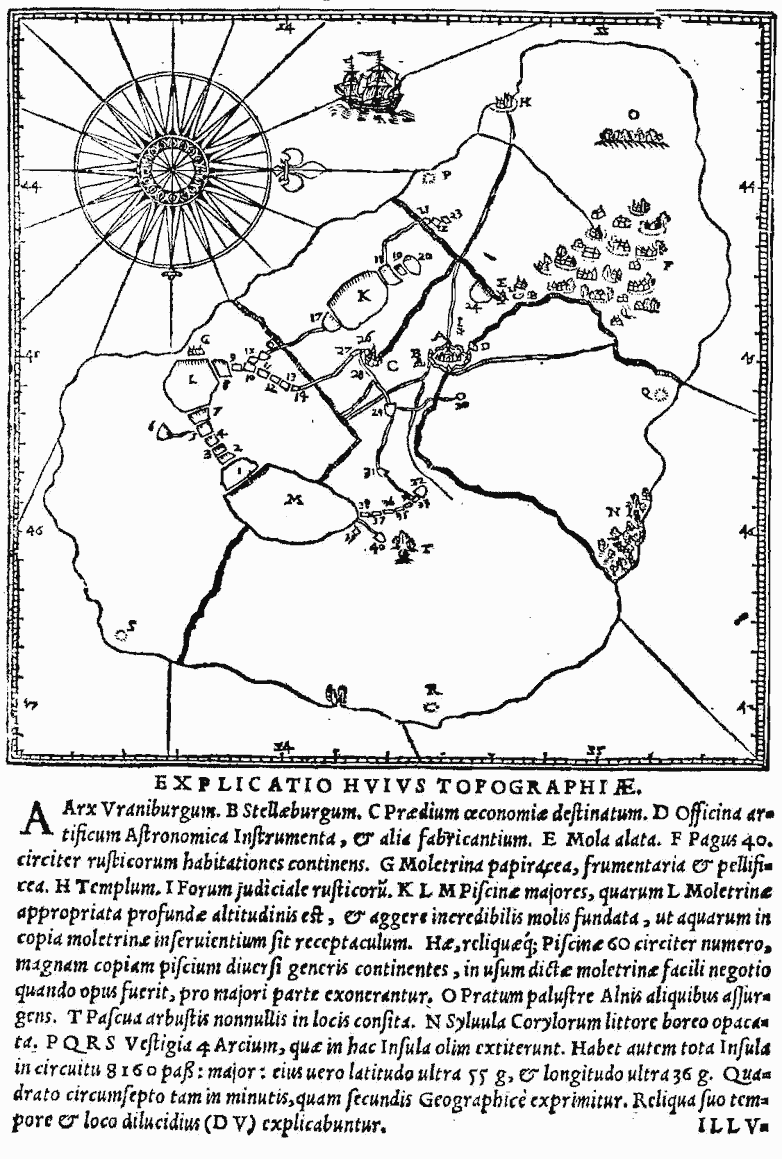
The fishponds which Tycho created by draining the small streams of the island lay to the south of the house and where these streams found their outlet to the sea was sited the papermill which Tycho later set up to supply the paper for his own presses. The position of the subterranean observatory Stjerneborg can also be seen on his map, lying just to the south east of Uraniborg.
The main house lay, precisely oriented at the four cardinal points at the centre of a square fortified enclosure (figs. 3 & 5). Gate houses were built over the entrances to the enclosure at its east and west corners. In the upper rooms of these gatehouses English guard dogs were kept to warn of any approaching strangers. At the north corner of the compound was a small building that housed the domestic staff. To the south a similar building contained Tycho's printing presses.
The house was surrounded by herb and flower gardens and between these and the outer wall were four sections of orchards, containing in total about 300 trees, each section having its own small garden pavillion. The map in Braun's Theatrum Urbium shows that provision was made for games of various kinds in the orchards surrounding the house while the rest of the island provided hares, birds and other small game for hunting and trapping.
The general configuration of the house with its square central block and round towers is clear from Tycho's illustration (fig. 5). Tycho's main alchemical laboratory occupied the basement of the southern tower and their top floors housed two of Tycho's observatories. The conical roofs of these observatories were constructed in sections which could be removed to allow a clear view of any part of the sky. The towers were surrounded at their upper level by wooden galleries connecting a series of smaller observatories and observation platforms. Over the centre of the house was an octagonal cupola with a gallery running around it and on top of this was a gilt weathervane in the form of a Pegasus. Also placed on the roof were "some octagonal constructions" which supported figures representing the four seasons. The house was served with a system of running water, the tank in the roof being supplied from a well which ran the whole height of the northern tower.
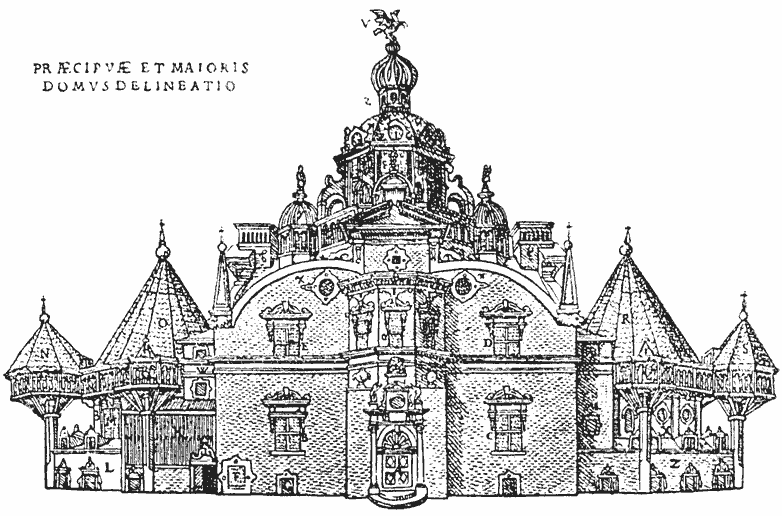
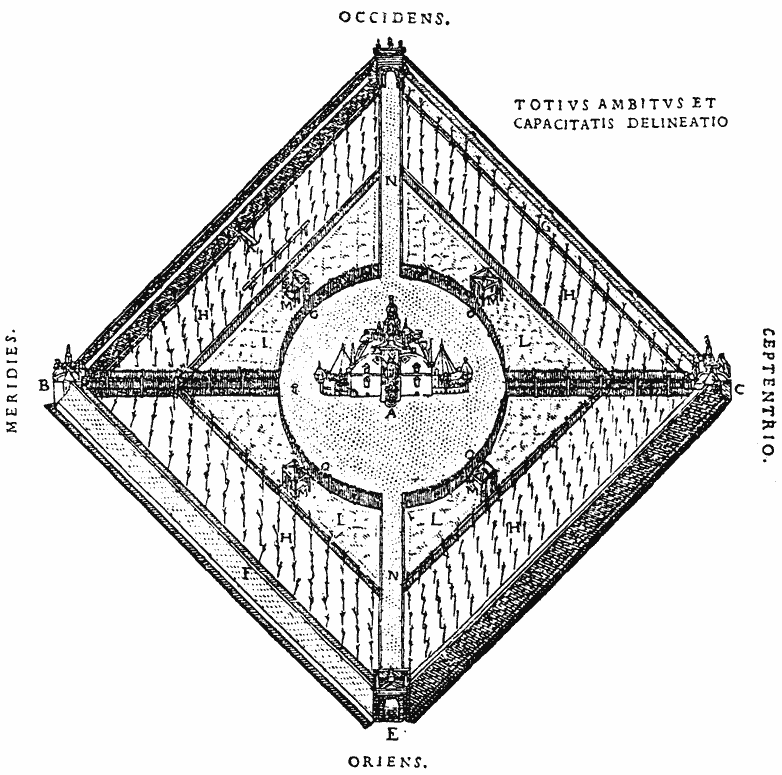
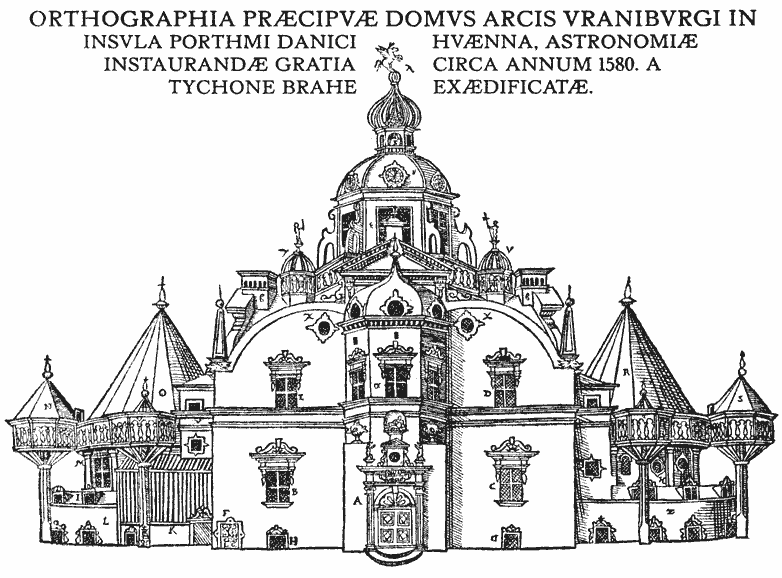
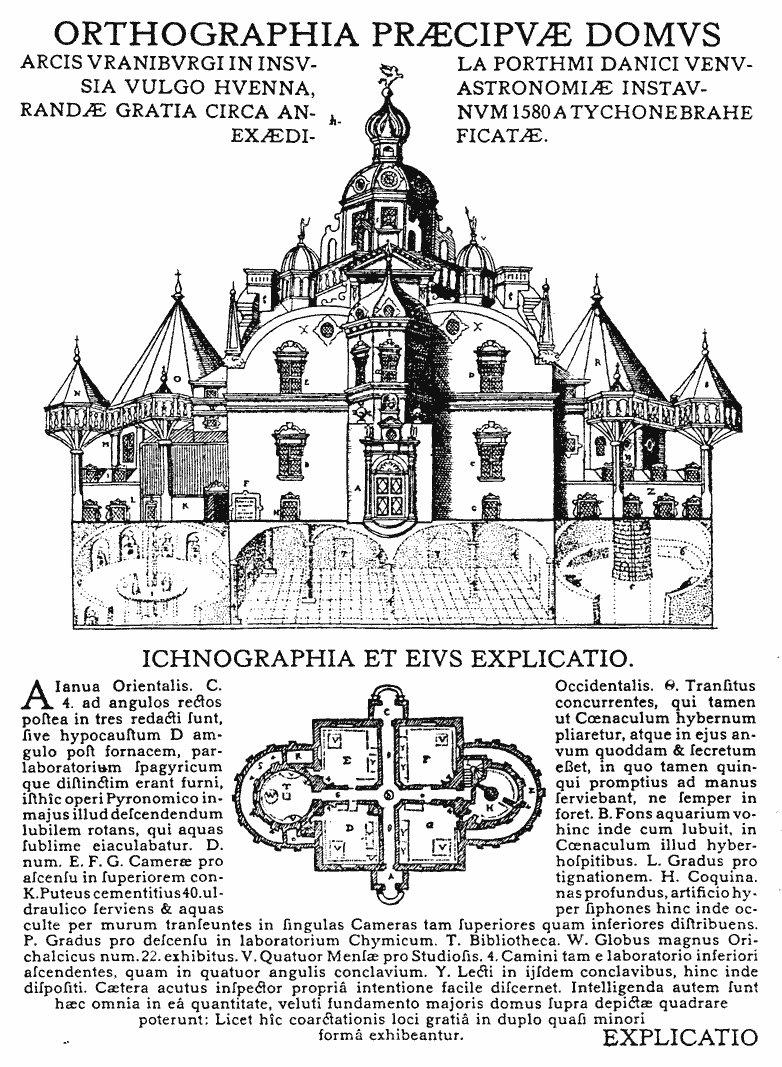
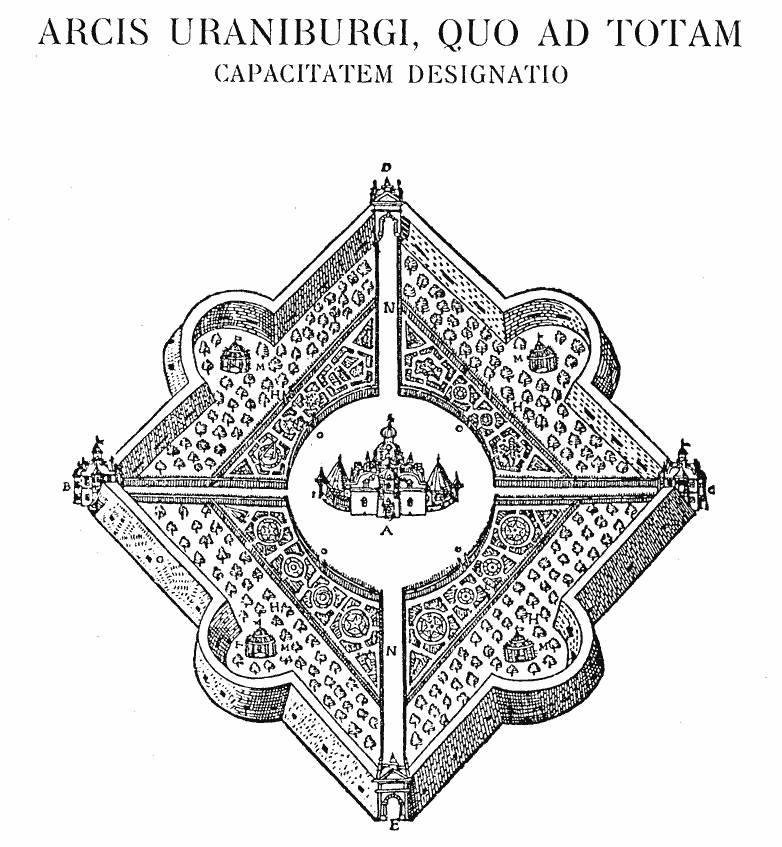
Although the names of two dutch architects are connected with the building of the observatories, it seems likely that Tycho superintended the work himself since he was in residence on the island throughout the time that building was going on. It is known that he took a great interest in architecture and references even suggest that he gave his principle architect van Steenwinkel instruction in french and italian architectural theorists as well as astronomy, geometry and perspective.’
A whole section in Astronomiae Instauratae Mechanica is devoted to the subject of building observatories and from the space and attention that Tycho gave to the illustration and description of the buildings and gardens on the island it seems reasonable to speculate that he played a large role in the planning of the enterprise. Certainly in the case of the underground observatory Stjerneborg, only someone who understood the workings and construction of the astronomical instruments (figs. 7, 10, 11 & 14) could have been responsible for its design given the level of integration of the instruments with the structure which contained them, and Tycho's descriptions show that he had a full knowledge of all the various aspects of the undertaking [9].
In Astronomiae Instauratae Mechanica Tycho describes the construction and workings of his instruments in technical detail and we find him constantly referring to the convenience and utility of his instruments and buildings, but sections of his text contain juxtaposed with the technical passages pieces which don't conform to the general pattern. These additional pieces use a language different from that used in the rest of the book and show Tycho in a very different light. In his description of the small gilt brass quadrant we find a lengthy explanation of the allegorical scenes engraved on the instrument, but as a post script Tycho adds,"All this I have wished to present here in detail on account of the added picture, even though it is perhaps irrelevant,” [10] so apparently disarming the passage he has just written. In his description of the great mural quadrant, the preface to a long section detailing the painting which occupies its centre contains the same kind of apologia, He describes the painting as being "only for the sake of ornament and in order that the space in the middle should not be empty and useless" [11]. It is difficult, given the apparent ambiguity of the text, to know how to interpret these sections but considering the labour which must have been put into the allegorical pieces and other 'ornamentation' and the fact that Tycho chose to execute and describe them they must be taken to be significant [12].
Other passages in Tycho's writing which diverge from the general pragmatic tone are the Latin verses and his quotations of inscriptions. They are printed, unlike the previous examples, without qualification or explanation. Tycho's writings relating to Uraniborg contain a verse in which he personifies astronomy as a figure, Urania, to whom the verse is addressed [13]. The verse explains the dedication of the house-observatory to astronomy, a dedication recorded in the name Uraniborg. Likewise in Tycho's renaming of the island Venusia and in the naming of his other observatory Stjerneborg we find similar dedications implied, to Venus and to the stars.
Consecrated to the all-good, great God and Posterity. Tycho Brahe, Son of Otto, who realized that Astronomy, the oldest and most distinguished of all sciences, had indeed been studied for a long time and to a great extent, but still had not obtained sufficient firmness or had been purified of errors, in order to reform it and raise it to perfection, invented and with incredible labour, industry, and expenditure constructed various exact instruments suitable for all kinds of observations of the celestial bodies, and placed them partly in the neighbouring castle of Uraniborg, which was built for the same purpose, partly in these subterranean rooms for a more constant and useful application, and recommending, hallowing, and consecrating this very rare and costly treasure to you, you glorious Posterity, who will live for ever and ever, he, who has both begun and finished everything on this island, after erecting this monument, beseeches and adjures you that in honour of the eternal God, creator of the wonderful clockwork of the heavens, and for the propagation of the divine science and for the celebrity of the fatherland, you will constantly preserve it and not let it decay with old age or any other injury or be removed to any other: place or in any way be: molested, if for no other reason, at any rate out of reverence to the creator’s eye, which watches over the universe. Greetings to you who read this and act accordingly. Farewell! [14]
In this inscription, which was placed over the door to the underground observatory Stjerneborg (fig. 7), the personification of astronomy is abandoned and it is presented as the divine science. The labour and precision of Tycho's astronomical observation is shown to be a revelation of the work of the "eternal God creator of the wonderful clockwork of the heavens" [15] and when Tycho describes himself as "he who has both begun and finished everything on this island" [16] in effect its creator, he implies a link between God's works and his own, his acts of making being a further means of honouring God. In these verses and inscriptions a deep intention is revealed in Tycho's work which elsewhere always remains implicit.
A study of these texts and his own descriptions of his house and instruments together with what is known of his life and astronomical work reveals several different interpretations of his buildings and gardens. Each dimension of his life animates the island in a different manner and the depth of Tycho's building enterprise can be seen by looking in turn at each of these dimensions.
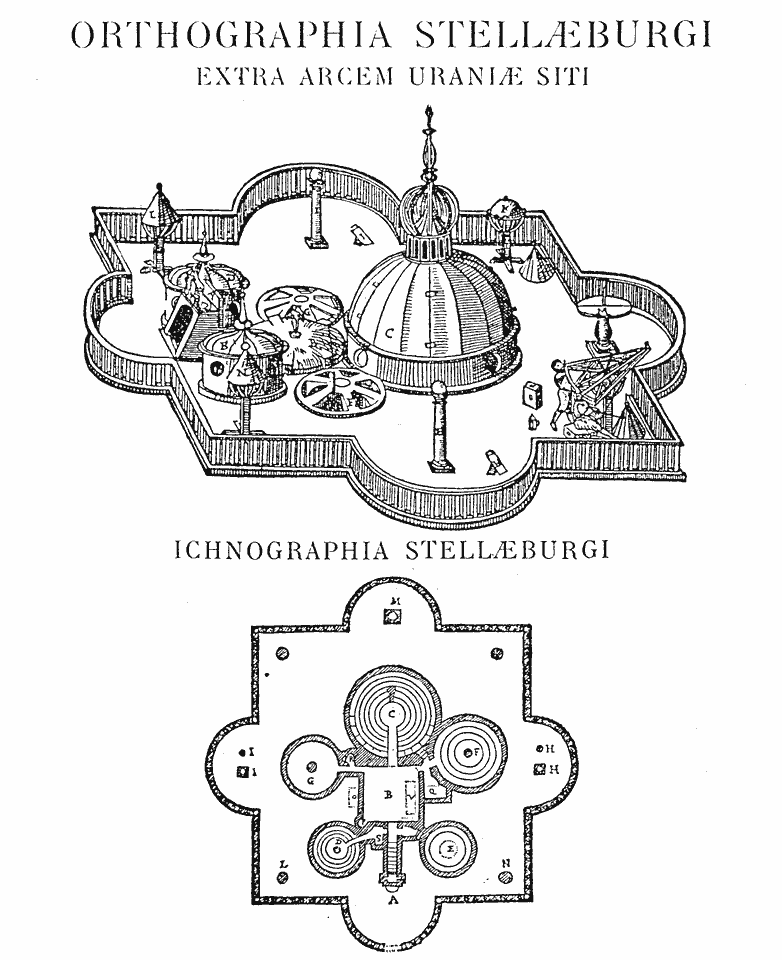
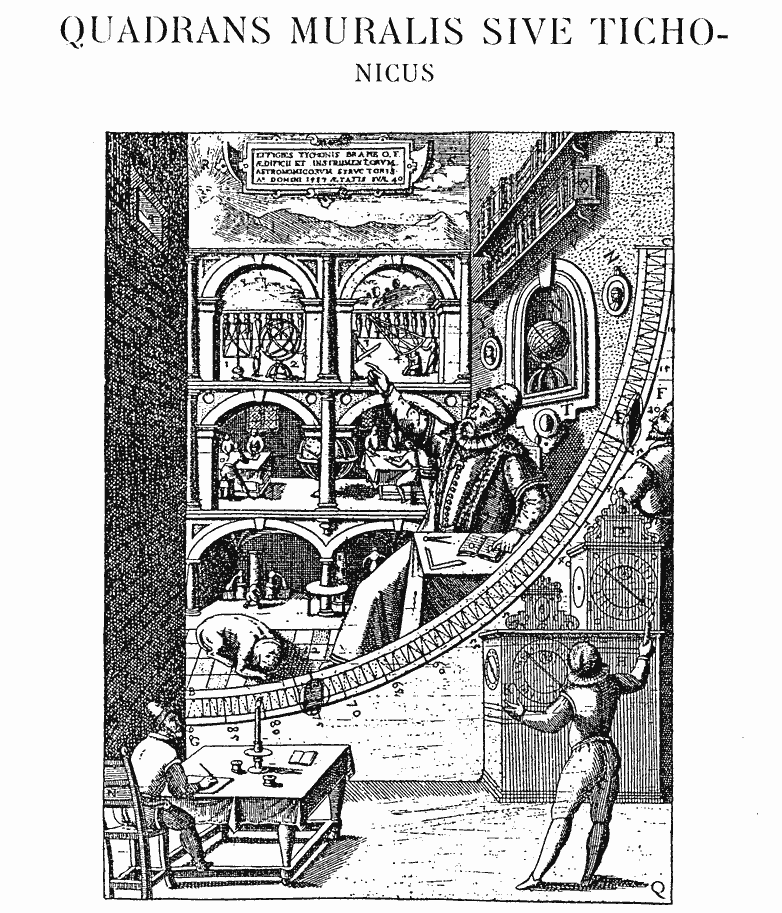
Chapter 2.
The social and domestic life of Uraniborg
Uraniborg was the country house of a Danish lord. Tycho lived there together with his wife and children and enjoyed the usual pursuits of a country gentleman. He had been given the island of Hveen in fiefdom by King Frederik II of Denmark specifically for the purpose of setting up an observatory [17], so much of the labour for Tycho's building works was provided by the peasants on the island who consequently made many complaints against him. The King was eventually forced to issue an "Arrangement and Rule for Tycho Brahe and the inhabitants of Hveen" setting a limit of two days a week on the amount of work Tycho might demand from each farmer [18]. Tycho was also required by the Crown to hold a petty sessions court once a fortnight which was held at the place of assize on a hill close by the house, and below one of the gate houses of Uraniborg there was a small prison where offenders might be detained. Tycho's renown as an astronomer drew scholars and other high-ranking visitors from all over europe who had to be entertained in a manner befitting their station and in the spring of 1590 Tycho received a visit from King James of Scotland [19].
Tycho's pupil-assistants, who numbered usually between six and twelve, also travelled from all parts of Europe to study and work with him. They lived with the family in the main house, occupying the garret rooms reserved for them in the attics. The King paid directly for the upkeep of half the pupils and Tycho the others. His domestic staff were accommodated in the small house already described at the north corner of the compound, but there were kitchens and stoves for food and wood in the main house.
Another member of the household was Tycho's dwarf Jeppe, who would sit at Tycho's feet at mealtimes and receive morsels from the table. He chattered incessantly and according to Tycho's pupil Longomontanus, was supposed to be gifted with second-sight. Tycho kept him for these skills and appeared to take his prophecies seriously. When anyone was ill at Hveen and the dwarf gave an opinion as to his chance of recovery or death he always turned out to be right [21].
The main rooms used by the family must have been those on the first floor listed by Tycho in his Description of the various parts of the main building in Astronomiae Instauratae Mechanica and linked to the accompanying view of the house by the use of letters: (fig. 5) "D. Chamber called the red one. α . A yellow octagonal chamber. E. The blue chamber. Facing the west and corresponding to these there is a large summer dining-room painted green the ceiling of which is decorated with pictures of the principle plants." [22] These must also have been the rooms in which Tycho's guests were entertained. Lacking a first floor plan the arrangement of these rooms and their relationship to Tycho's two observatories in the upper parts of the north and south towers can only be guessed at, but from the ground floor plan contained in the accompanying illustration a clearer idea of the arrangement of this part of the building is possible.
The four principle rooms are represented in a similar manner, all containing beds "put in various positions" [23] and also "tables for the collaborators", Tycho's pupils. Of these rooms, those lettered 'E', 'F' and 'G' on the plan are described as "spare bedrooms" and 'D' as a "Winter dining-room or heating installation". Tycho explains how one of the four rooms was expanded to form this winter dining room and how in this expansion he created "a small hidden chemical laboratory, in which, however, fire furnaces were placed apart, which might be more quickly at disposal for the chemical work there." After this expansion the library must also have opened off this room. The adjoining ‘spare bedroom' to the south west later contained Tycho's great mural quadrant and if we can trust Tycho's plan then another of the ‘spare bedrooms' formed the connection between the main house and the kitchen located in the base of the northern turret. 'R' and 'O' were apparently aviaries flanking Tycho's library.
Prefacing his description Tycho warns the reader, "it is nearly incredible that this house should contain such heterogeneous things" [24] and even within this one floor we can see how the ‘heterogeneous things' contained were found together in close proximity. On the ground floor at least there is little distinction between those rooms which were a part of the domestic life of the house and those areas used for Tycho's study.
Tycho as homo faber
In Astronomiae Instauratae Mechanica Tycho summarises his alchemical work in a single paragraph:
I also made with much care alchemical investigations, or chemical experiments. This subject too, I shall occasionally mention here, as the substances treated are somewhat analogous to the celestial bodies and their influences, for which reason I usually call this science terrestrial Astronomy. I have been occupied by this subject as much as by the celestial studies from my 23rd year, trying to gain knowledge and to prepare it, and up to now I have with much labour and at great expense made a great many findings with regard to the metals and minerals as well as the precious stones and plants, and other similar substances. I shall be willing to discuss these questions frankly with princes and noblemen, and other distinguished and learned people, who are interested in this subject and know something about it, and I shall occasionally give them information, as long as I feel sure of their good intentions and that they will keep it secret. For it serves no useful purpose, and is unreasonable, to make such things generally known. For although many people pretend to understand them, it is not given to everybody to treat these mysteries properly according to the demands of nature, and in an honest and beneficial way. [25]
A sharp distinction is made between the science which Tycho considered public and hence publishable, and that which must remain only in the hands of the trustworthy. If we can believe Tycho then half his work was conducted in this secret realm and consequently we have little record of it. He hints in the above passage at the "somewhat analagous" relationship between alchemical (terrestrial) substances and celestial bodies. We find this analogy restated in a pair of plates which occur frequently in his published work, which illustrate alchemy and astronomy respectively and demonstrate the reciprocal relationship of influences which exists between the terrestrial and the celestial. In the same letter in which Tycho explains these plates to his friend Rothmann, he reveals his knowledge of the "occult philosophy" and lists the authors he has followed [26].
His belief in the existence of occult relationships between celestial and terrestial phenomena was crucial to Tycho's astrology in which the fate of man is linked with the movements of celestial bodies [27]. The book on weather prognostication published at Uraniborg by one of his pupils, Peder Flemlose, contains 399 rules on how to foretell changes in the weather by the behaviour of animals and the appearance of the sky, sun, moon and stars and shows us how the web of influences and sympathies was thought to include every aspect of the created world [28]. Occult science also formed the basis for Tycho's medical practices and he prepared medicines and elixirs in his alchemical laboratories using such principles as "tanquam simile suo simile", to guide the composition of his concoctions [29].
The herb and flower gardens which surrounded the house supplied his laboratory, although the description of his medicines show that other substances must have been especially brought in to augment those things which might have been found or cultivated on the island.
His main laboratory in the basement of Uraniborg is clearly described in Astronomiae Instaruatae Mechanica and its subterranean position within the house is important, but what is also important about Tycho's alchemical practices to an understanding of the house is the occult philosophy upon which they are based. Tycho's attitude towards "terrestrial Astronomy" [30] and its indivisibility from the celestial demonstrates the invisible sympathies and influences which he understood as pervading not just the realms of alchemy and astronomy but everything contained in the building and gardens of Venusia.
Paint, cloth, wood, brass, steel, iron and stone were all skilfully combined by Tycho in the construction of his instruments. The success of his invention in this field was based on a deep intuitive understanding of the nature of the materials at his disposal and the purposes to which they might be put, an understanding which like his alchemical knowledge could only be gained through direct experience, "per ignem" [31]. A typical example is his use of laminated wood in the construction of the large armillary rings described in the section of Astronomiae Instauratae Mechanica devoted to the description and use of the equatorial armillary instrument:
The two armillae crossing each other at right angles within the first one, are, as I have mentioned, covered, though only on their outsides, with strong brass plates, which carry the divisions. They are not entirely covered with brass, because that would make them too heavy. They are made of pieces of wood joined together and bent into a circle, and many times coated with pitch, and in such an ingenious way that they are not formed of one solid piece of wood, but of several that are finely smoothed and flat, and very carefully glued together. The grain of each successive piece is reversed so that the directions of their respective tips and roots alternate. Experience has taught me that this is the way to treat wood intended for use in instruments in order to prevent bending and other changes. Of all kinds of wood walnut and the kind of spruce which the Germans call Feuchtenholtz are the best ones, provided they have not been damaged, and have been dried for a long time. When the armillae have been made in this way by glucing small wooden sticks together, and when they have got their proper shape and size, then fine linen or parchment is glued all round them, and they are coated and coloured with a mixture of white lead and linseed oil in order not to be too sensitive to changes of the weather. [32]
Also illustrative of these concerns is his description of the making of the great celestial globe discussed later [33].
Tycho's workshops which lay immediately outside the main compound of Uraniborg not only produced the astronomical instruments but also the various mechanical gadgets and automata which were scattered throughout the house and gardens. The dome over the centre of Uraniborg housed machinery which connected the gilt weathervane in the form of a winged Pegasus, with a dial in the ceiling of the chamber beneath [34]. On this ceiling another pointer turning on the same axis displayed the time. Tycho had other clocks made for use in his astronomical work and his great mural quadrant framed another piece of clockwork machinery inside a gilded globe arranged so as to “immitate the diurnal rotation, and also represent the course of the sun and moon" [35]. At the very centre of the house on the ground floor was an animated fountain "provided with a water-carrying figure, which turned round and threw the water into the air in all directions when this was wanted” [36].
Tycho's various automata gained him a reputation as a sorceror amongst the peasants on the island [37]. It is difficult, now, to imagine how startling these toys must have seemed, but the properties of animation which Tycho's mechanisms enabled were considered close to magic and to create such an animated figure was apparently to create life. Tycho's description of God as "creator of the wonderful clockwork of the heavens" [38] shows the analogy that was drawn between common mechanisms and the motion of the planets, which encouraged their mechanistic interpretation. The same mechanical interpretation of nature was applied to the human body and early mechanical theories of life have their roots in the study of such automata.
If a parallel can be drawn between the acquisition of alchemical knowledge through direct experiment and the understanding of materials through the craft of making instruments, then a similar parallel can be seen in Tycho's experiments with machines and his making of automata. If mechanism is taken to be a primary phenomenon and structure of nature then the direct experience of mechanisms through making allows the maker a deeper understanding of nature.
Celestial measurement
If we are to understand fully Tycho's work in the field of celestial measurement then we must remember how highly he regarded astronomy. For him the motion of the heavens was divine, having been created by God, and the act of measuring this motion was a kind of revelation. Tycho's instruments were his link with the divinity of the heavens and through them he was able to translate the motions of the skies and planets into the abstract numbers of angular measurement.
In the majority of instruments the principle of measurement is the same. The simplest possible case is that of a fixed quadrant: one part of the instrument, the alidade or some arrangement of sights, is free to move and would be linked by the sighting of the observer to a particular celestial body. The other part which holds the scale against which the alidade is read, remains fixed. The angle which is read off the scale records the relative position of the celestial body to that of the earth in the form of number. The alidade could be understood as representing the position of the celestial object to which it is directed, and the body of the instrument could be understood as representing the position of the earth to which it is linked by its mounting. It is the comparison of position enabled by the instrument that constitutes the measurement.
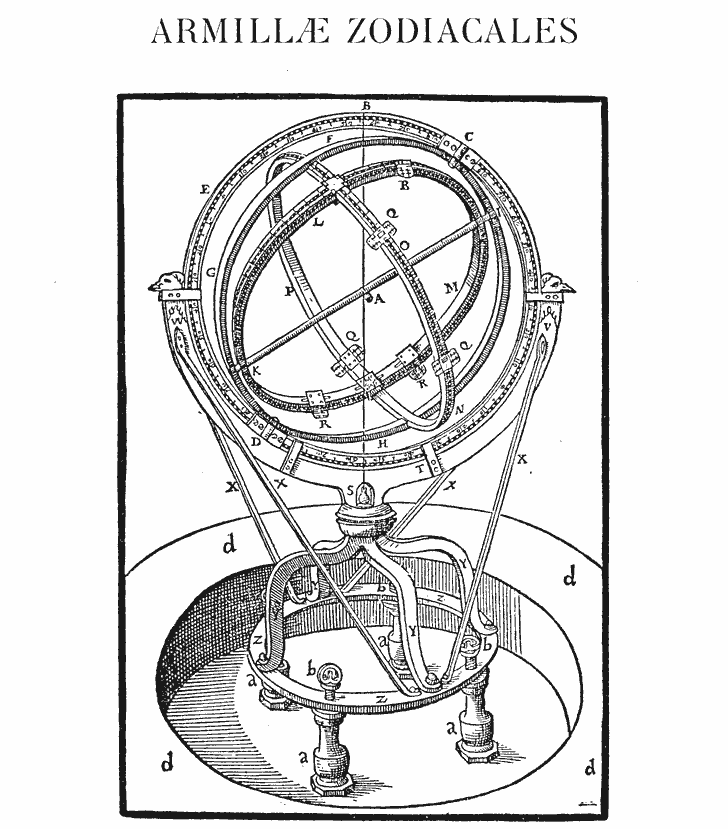
Although more complex the armillary spheres also illustrate the same principle [39]. Tycho explains in his description of the zodiacal armillary instrument, (fig. 13) how the main armilla, EBCNH, "represents" the meridian and explains how it must be placed in such a way that it coincides with the celestial meridian.” The next armilla is called the ecliptic and when a measurement is to be made it must be aligned so that it coincides exactly with the celestial ecliptic, i.e. so that it may represent it. Measurements can then be made relative to these two represented conceptual celestial circles. Tycho also explains how the instrument may be adapted so that the armillae will not "have their planes forced out of coincidence with the planes they represent." [40] The astronomical concepts of meridian, ecliptic and zodiac are then embodied in these instruments finding their physical representation in steel and wooden rings.
The perseverence which Tycho exhibited in his building of the great celestial globe (fig. 16) is proof of the importance he attached to it [42]. Made in Augsburg and then transported to Hveen five years later in a damaged state Tycho spent years over its completion allowing months to elapse between each successive stage of work on it to check for any possible movement or departure from the globe's perfect sphericity. Finally covered in brass and engraved with hundreds of Tycho's carefully observed star positions the globe was placed in the library at Uraniborg, a direct record of his observational work.
The translation of the dome of the heavens into the objectified form of a celestial sphere represents a substantial conceptual transformation; that which in perceptual reality surrounds the viewer is transformed into a tangible object which he views from without. The link between observed reality and this representation was in the form of number. Tycho's tables contained all the information marked out on the globe but he still saw this further representation as necessary, and not simply as a tool for his astronomical work. Along the horizon of the great globe was written the following inscription:
In the year of Our Lord 1584, when Frederick II ruled in Denmark, Tycho Brahe, Otto’s son, had this globe made for himself and for his successors, in . accordance with the mechanics of the heavens. It was his intention to represent exactly the stars fixed to the eighth sphere, each in its proper position, having observed them in the sky with his instruments, and with the help of these to investigate the appearances of the wandering stars, thus by a mechanical piece of work opening the sky to those of the inhabitants of the earth who are able to comprehend this system of reason. [43]
Tycho then saw the globe as possessing revelatory properties by virtue of its particular method of representation.



The link between the instrument and the earth referred to above is made manifest in the four-square geometry of the bases of the instruments. These bases embodied the instruments' alignment with the meridian, in terrestrial terms a line running due north south, an alignment which was integral to the instruments' scientific task. The relationship between the azimuthal scale (the scale of the instruments which was related to the meridian) and the bases of the instruments is shown clearly in both the medium-sized azimuth quadrant and the (fig. 8) great azimuth semicircle [44]. This four-square geometry and orientation of the instruments to the cardinal points is crucial to the task of celestial measurement and it is this same geometry which we find restated in the layout of the house and gardens.
One of Tycho's parallactic instruments was placed in one of the towers of the main house [45]. The instrument occupied the whole room within which it was free to rotate and azimuth measurements could (fig. 12) be read off a callibrated brass strip running around the inside of the wall. The room itself then provided an artificial horizon for the instrument along which measurements could be taken. In this instrument we can see a direct link between the geometry of celestial measurement and the geometry of the house, the same link that is expressed in the bases of the other instruments.




The instruments at Stjerneborg shared the same kind of link between instrument and room [46]. The dished, stepped floor of the (figs. 10 & 11) rooms together with wrought iron frames which rose from the top of the surrounding walls provided a three dimensional cradle for the whole instrument. The most highly developed of all Tycho's instruments in this respect was the great equatorial armillary at Stjerneborg. In this piece the largest armilla (A) (fig. 14) was braced by a framework of iron bars which inscribed it with a pattern of interlocking equilateral triangles. The hollow cylindrical steel bar which formed the axis of the armilla was held at its upper end by a wrought iron bracket which branched into two limbs brought to rest on columns at either side of the entrance to the chamber. At its lower end the axle was located in a small hole in a steel disc which rested on a stone foundation via an adjustable mounting. The stone mounting was four cubits long and lay half buried in the ground. The upper part of the stone carried "on the front side, a statuette representing Atlas, king of Mauretania, ingeniously chiselled in the same stone" [47]. His crown touched a stone-globe (H) mounted on top of the pillar "for the sake of decoration". Tycho is again disarming with his use of language, and despite his explanation the whole piece remains a very curious object. Furthermore Tycho describes the wall surrounding the instrument as forming a sort of "small turret or semi-subterranean crypt around the whole instrument."
At Stjerneborg Tycho wished to improve the accuracy of his instruments by giving them a secure foundation, sheltered from the winds which disturbed them in his tower observatories. In so doing Tycho placed his instruments into a much closer literal and conceptual contact with the earth. He was thus able to provide a foundation stone for the great equatorial armillary which rested directly in the earth and we find its literal properties as a support figuratively expressed in the representation of Atlas, carved as Tycho carefully notes from the same stone [49]. The representational properties of architecture are again revealed in the management of the support at the other end of the instrument and the two columns which flank the entrance to the crypt. In this manner the link between sky and earth does not simply lie within the geometry of the instrument and its scales but is contained in the whole building both in its geometric and tectonic structuring about the instruments and in the figurative dimensions of its architecture.
Iconography and geometric symbol
The iconographic collection
Scattered throughout Uraniborg and Stjerneborg we find carved painted figures used in an allegorical or embltematical manner. Together with the portraits and inscriptions these form a substantial iconographic collection. Two of the instruments published in Astronomiae Instauratae Mechanica exhibit the use of emblematic and allegorical pieces which Tycho explains in detail, but although he mentions (and illustrates) similar pieces relating more closely to the buildings he is not so forthcoming in his explanations. The precise iconographic intention of placing a winged Pegasus over the centre of the house or a bronze reproduction statue of Mercury on the grassy mound over the main chamber of Stjerneborg is elusive but where Tycho groups together figures or introduces inscriptions, as with the allegorical scenes on the instruments, an interpretation is more feasible [50].
Such a grouping of figures together with inscriptions we find in the principle room at Stjerneborg [51]. Around the walls of the chamber were painted eight reclining figures six of whom were notable astronomers of history. Tycho places himself within this historical lineage by adding his own portrait to the others. The eighth figure was a fictitious astronomer, Tychonides, who it was supposed might follow Tycho at some time in the future. On the ceiling was drawn a representation of Tycho's model of the universe to which Tycho's figure was shown pointing accompanied by the inscription "Quid si sic?".
In representing himself in this manner and in explicitly describing the task which he considered himself to have undertaken in inscriptions such as that found over the front doorway to Stjerneborg [52] Tycho was self-consciously placing himself in history, as one of the great astronomers. Perhaps then the crowned figure of Atlas, King of Mauretania supporting the ambiguous globe beneath the great equatorial armillary in the southern chamber of Stjerneborg [53] can be read as another representation of Tycho as he saw himself: Tycho Brahe, King of Venusia, champion and bearer not of the terrestrial globe but of the celestial globe of Urania.
We have seen how Tycho's life was divided between the two realms of alchemy and astronomy - one half of which was kept secret and hidden, the other public and widely published. Uraniborg embodied a representation of these two sides of Tycho's work. Over the Eastern doorway was carved a relief based on one of the vignettes which are found in Tycho's published work [54]. In this first case the reclining figure is seen leaning on a globe holding a pair of compasses in (fig. 17) his hand, his face turned up towards the sky. Then placed over the Western doorway was a relief taken from the second vignette. The figure now has at his side some chemical apparatus and he holds in his hand a bunch of herbs. The Snake of Aesculapius is coiled around his arm and he looks downwards. The motto of the first relief is "Suspiciendo despicio", and that of the second "Despiciendo suspicio". While representing the two sides of Tycho's work the two pieces show the reciprocal relationship between the two realms and their ultimate indivisibility. Placed as they were at Uraniborg the reliefs were linked with the two sides of the house conceptually dividing it into two realms, one related to alchemy and the other to astronomy. This can be read in the presence of the village, the place of assize and Tycho's workshop to the west of the divide on the alchemical and terrestrial side, and the presence of Stjerneborg to the east. The house was the place where the two realms were brought together.
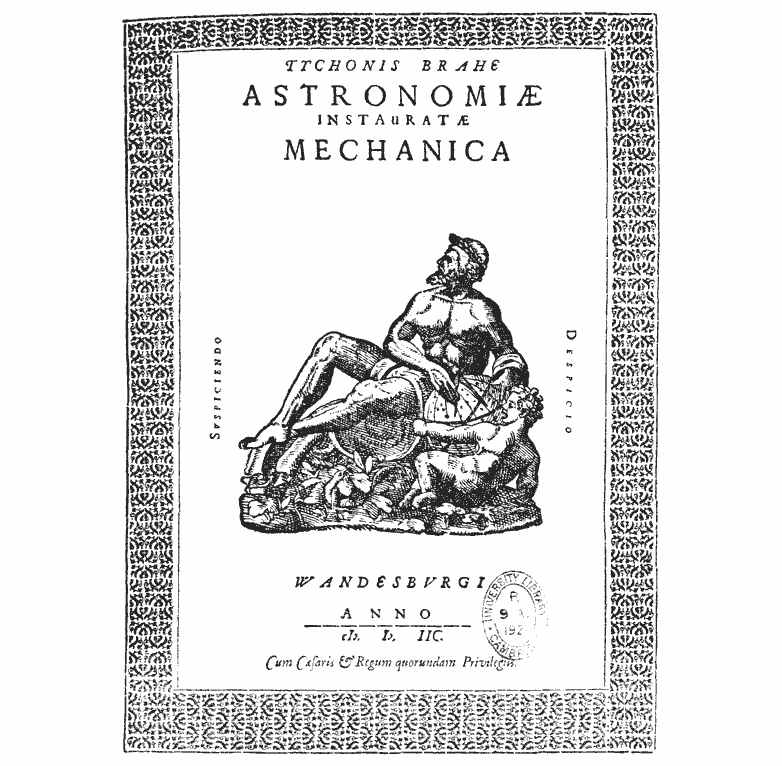
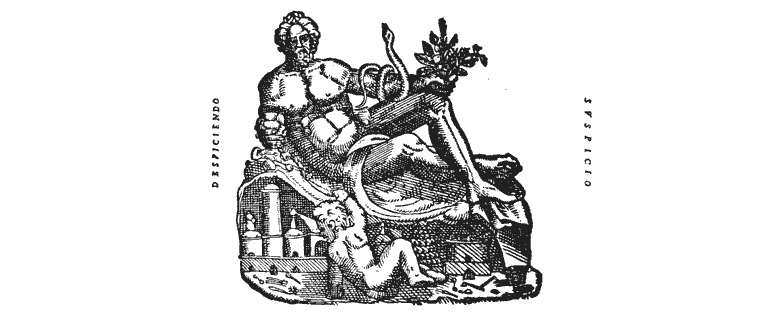
Uraniborg as geometric symbol
In the introductory discourse to a course of lectures given by Tycho at the university of Copenhagen during the autumn of 1574, Architecture appeared amongst the branches of knowledge derived from geometry [55] and in his description of Uraniborg in Astronomiae Instauratae Mechanica he pointed out how the building was laid out "so that everything corresponds mutually and is strictly symmetrically arranged, as required with architecture if the work is to be executed in a proper manner according to the roles of the art" [56] Uraniborg embodied a geometrical structuring which was not common in contemporary buildings in either Holland or Denmark [57].
The primary form of the building with its bi-axial symmetry is attributed by Becket to Tycho's (supposed) knowledge of Palladio's work, specifically the Villa Rotonda, through I Quattro Libri dell' Architettura (1570) and perhaps directly from his visit to northern Italy in 1575 [58]. However a comparison of the two buildings reveals substantial differences [59]. A search of other literary sources of (fig. 18) which Tycho might well have been aware, given his wide literary knowledge and interest in architecture, reveals several other images to which the woodcuts of Uraniborg bear a strong resemblance. Similar illustrations of the mausoleum at Halicarnassus appear in both Ceseriano's and Rivius' editions of Vitruvius, shown as a symmetrically planned, (figs. 19 & 20) centralised building [60]. Also in Vriedemann de Vries' architectural books we find a similar temple-like building illustrated, although again this occurs in an urban setting [61]. The possible use and meaning of these buildings as precedents must, however, remain largely conjectured, (fig. 21) but another dimension of interpretation lies within Tycho's statement of the link between architecture and geometry.




In Astronomiae Instauratae Mechnica Tycho stresses the importance of the accurate establishment of the meridian and explains how this may be done by careful sighting of the pole star and the tiny circle it appears to describe in its diurnal motion [62]. (The primacy of the meridian has already been explained in the section on celestial measurement.) He also stresses the precision with which the house of Uraniborg was oriented, "with its four sides, which form a regular square, exactly facing the four points of the sky" [63] Tycho's precision in the laying out of the building is revealed by the presence of the great mural quadrant against the west wall on the ground floor of the building, (The quadrant relied on being oriented exactly parallel to the meridian in order to be effective).
But this orientation was not limited only to the scale of the house. The gardens and fortifications contained the figure of the square stated twice more with the corners of the square rather than its sides facing the cardinal points. In addition fig.6 shows how tangents to the apses in the external fortifications form a square of exactly the same dimensions as the main enclosure on the same orientation as the house. The same figure was used in the enclosure to Stjerneborg although here it was rotated through forty five degrees. At a smaller scale within both the house and at Stjerneborg the precise orientation was also present and was revealed quite explicitly in those places where the astronomical instruments were linked directly with the fabric of the building [64]. At many scales orientation to the four cardinal points was a recurrent and constantly stated theme.
The practice of making celestial observations to determine the orientation of buildings provides a link between Tycho and Vitruvius. Vitruvius used the sun and not the pole star in his determination of the meridian [65]. His method was not as accurate as Tycho's but his primary intention was the same: the determination of the cardinal points. His explanation is found in book one of his Ten books where he discusses the orientation of streets in relation to the direction of the winds. The winds, he thought to be eight in number oriented about the cardinal points. As proof of this he cites the tower of the winds at Athens, an octagonal tower oriented about the cardinal points and surmounted by a weathervane in the form of a Triton which pointed towards whichever of the eight winds was blowing.
If Vitruvius' instructions on the setting out of the cardinal points are followed their product is a geometrical figure drawn on a marble slab called by him an amussium. Cesariano's interpretation of Vitruvius' amussium with the geometrical figure inscribed on it is shown in fig. 22. [66] This figure, often represented as here in the form of two interlocking squares, serves to link the eight winds to the cardinal points. The geometric symbol we find in the amussium illustrates the ability of the use of such a figure to embody and relate diverse elements.
A further use of geometry and in particular the figure of the square to embody such relationships is shown in figs. 23 & 24. This class of geometric figure, known as the Tetrad, was understood to be a fundamental mechanism of the cosmos and was thought to underlie every set of relationships between the items of nature. Thus we find the cardinal points related not only to the winds but also to the seasons, the points of the zodiac, the elements and their qualities, and the humours and ages of man [67].
If Tycho's use of geometry is seen in this light as a unifying principle which underlies and permeates the whole of the site of Uraniborg linked to the cardinal geometry of the sky, then the building and its grounds can also be read as a true geometric symbol analagous both to the Tetrad and the Amussium in which the primary relationships between diverse elements are embodied.


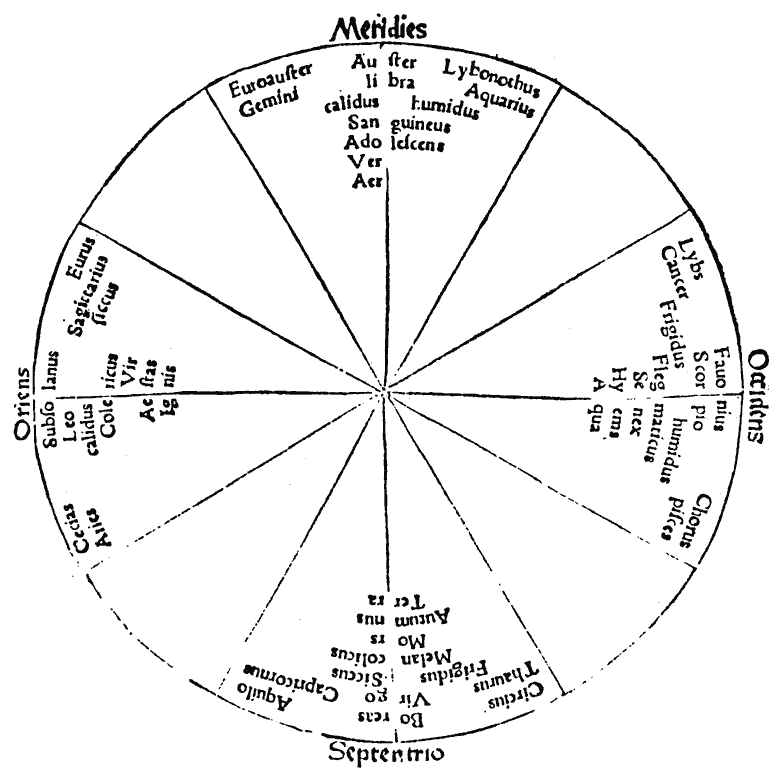
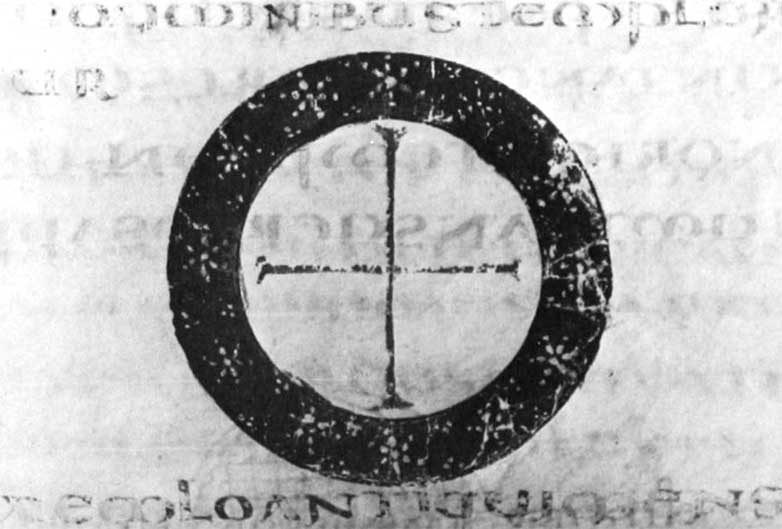
Chapter 3.
The meeting of earth and sky
But with a firm and steadfast mind one should hold, under all vicissitudes, that everywhere the earth is below, and the sky above [68].
We have seen how the island is animated by a series of different themes which run across it. In domestic terms Uraniborg was a house and provided a place of shelter and habitation for Tycho and his household where they could live protected from the wilderness outside by the fortifications which surrounded them. In Tycho's activities as an alchemist and maker we can see both his intuitive knowledge of materials and mechanisms and the analogies that he senses within them, and the explicit beliefs of occult philosophy which attempted to frame these intuitions into a science. Through this we have seen the invisible web of influences and sympathies which was thought to connect all aspects of nature and within which the house was placed. We have seen how Tycho's knowledge and intuitive understanding of celestial geometry gave him a very particular understanding of geometry as it might be related to architecture and we have seen how this is apparent in the way that Uraniborg and Stjerneborg were linked, partly through the instruments and partly through their own geometry, to the geometry of the heavens. Tycho's Latin verse, his inscriptions and his figurative iconography represent a continuity which ran through his books and instruments as well as the buildings and which served to link them, within which Tycho was able to articulate certain of his theories and aspirations. Finally through his understanding and use of geometry and measure he was able to make at Uraniborg a very special site.
The building is carefully placed by Tycho in space and time. It is situated in space through the marking and remarking of the site of the house in the landscape through the geometry of the gardens and fortifications. His measurements of the latitude and longitude of the house by celestial observation place it precisely within the geometry of the earth [69]. He placed the building in time with the care of an astrologer placing the birth of his subjects in astrological time, through his attention to the building's foundation as it is embodied in the inscription on Dancey's stone [70]. The temporally and spatially fixed place could then be a suitable site for Tycho's work.
Tycho's understanding implied that revelation existed in the careful study of the various different branches of knowledge and in their consideration together. It is only in an understanding of their relationships to one another and to man that a true view of nature could lie. The house of Uraniborg is the meeting place for these diverse dimensions of knowledge.
The dimensions of knowledge are embodied in the building in the form of the two opposites alchemy and astronomy which reveal their ultimately indivisible nature in their symmetry and reciprocal relationship.
It is not only in the east west division of the house discussed previously that we find the two realms made explicit. Both in the representation of the building which occurs in Astronomiae Instauratae Mechanica and that which was painted on the wall within (figs. 5 & 9) Tycho's great mural quadrant [71] there is a clear vertical heirarchy with alchemy represented at the bottom by the laboratory, and astronomy by the presence of the instruments and the observatory above. In both cases the building provides the architectural setting and geometric framework by which the division, heirarchy and the ultimate reconciliation of the two opposites can be understood.
This bringing together of the two sciences was constantly restated at Uraniborg: through their common presence in the house; through the expression of the occult forces which were thought to bind them; through the unificatory power of the geometric symbol which encompassed the site; and through their representation together in pictorial allegory and in text. Uraniborg was a house of wisdom, the place where earth and sky were brought together and in that bringing together, a symbol for the synthesis of all man's knowledge, lay Tycho's key to divine revelation.
The question of intentionality still remains. To what extent would Tycho have shared this kind of interpretation of his efforts on the island and to what extent is the building a ‘conscious' representation? My answer would be that Tycho's perceptions gave him a completely different view of Uraniborg from that which we have now. For him as a maker and inhabitant Uraniborg was a built and lived reality. His scholarship provided him with an explicit means of representation but beneath his scholarship lay a deep intuitive knowledge. In Tycho's making it is not just his scholarship which is revealed but all the dimensions of his understanding.
In his task of gaining long term notoriety Tycho was successful but his dedication of the buildings of Uraniborg to posterity was less so [72].
You house dedicated to Urania, renowned beacon, erected in a high place and fortified with walls, surrounded by trees and lawns in your gardens, you, who in three times seven years have investigated all stars, while lifting your majestic head towards the Olymp-do you now stand unheeded? Do you stand silently and have been deserted? Perhaps it was so decided by the High Powers watching god-inspired thoughts. In order that the great tasks shall not be confined within narrow barriers they stir up everything earthly and have it changed in every manner. Glory be to you alone who governs the rotation of the heavens and the stars.
On the death of Tycho's royal patron Frederick II the Danish crown was assumed by the young King Christian IV who although impressed by a visit to Uraniborg at the age of fifteen was persuaded by members of the court who had taken a dislike to Tycho to withdraw the pension and canonry which supplied his income [73].
On all this: I have spent more than a tun of gold [100 000 Rigsdaler]. For all that I could gather, cither gifts from the King or from my own annual income, I spent on this object, to say nothing of the huge work and trouble I have undergone over there during twenty-one vears. From this and several other facts every sensible person will easily conclude that I must have had very weighty reasons, particularly at the age of fifty and with a large family, to leave an island which to me had so great a value, and further my beloved native country and so many relalives and friends I had there. But which and how great reasons have moved me to do so, I prefer not to mention in this place.
Tycho then, deprived of financial support and being in the court's disfavour, collected his instruments and left for Rostoc where he spent a year with his friend Henry Rantzau before moving to Prague at the request of Emperor Rudolf II, his next and last patron.
Already in 1599 Eske Bille, a relative of Tycho, had written to him to tell him of the poor state of the buildings. Tycho replied to him: "As to the farm and the castle itself being in bad repair, I can only say, as I have done before, that I do not intend to go to any further expense about it; there was far too much money spent on it before, and if I had the money back, it should hardly be so badly spent" [74].
with special thanks to Peter Carl and Professor John North
notes:-
7. See Steenwinkel's biography in Skovgaard A King's Architecture (appendix II)
17. See J. Dreyer Tycho Brahe p. 86-7
23. See Ast. Inst. p. 129 for this and quotes immediately following.
28. P. Flemlose En Elementisch eller Jordisch Astrologia on Luftens Forendring
29. Dreyer Tycho Brahe p. 130 contains other details of Tycho's medical work.
31. See Dreyer on Tycho's alchemy: Tycho Brahe p. 129
37. See Gassendi Tychonis Brahei vita p. 196
39. For Tycho's descriptions of the armillary spheres see Ast. Inst. p. 52-63
42. For Tycho's description of the great celestial globe see Ast. Inst. p. 102-105
44. For descriptions of these instruments see Ast. Inst. p. 16-19 and p. 40-43
45. Another parallactic or ruler-instrument Ast. Inst. p. 48-51
50. See F. Becket appendix III
55. Tycho Brahe Opera omnia I p. 146-47
58. See F. Becket Uraniborg & Stjerneborg p. 35
62. Ast. Inst. p. 34 for Tycho's reference to the precise determination of the meridian.
74. See Dreyer's reference to Breve of Aktstykker in Tycho Brahe p. 376
